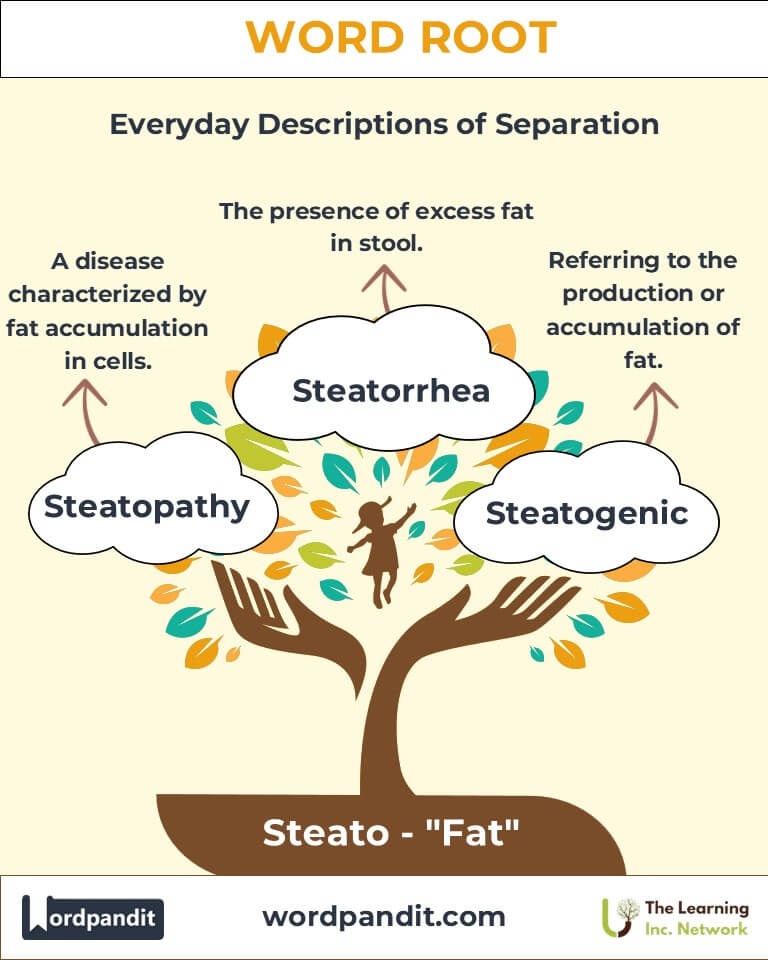Steato: The Foundation of Fat in Language and Medicine
Discover the fascinating world of the word root "Steato", derived from the Greek word stear, meaning "fat." From clinical terms like steatoma to anatomical features like steatopygia, this root has significant relevance in medicine, biology, and beyond. By exploring "steato," we uncover its importance in understanding health, physiology, and culture.

Table of Contents
- Introduction: The Essence of Steato
- Etymology and Historical Journey
- Mnemonic: Unlocking the Power of Steato
- Common Steato-Related Terms
- Steato Through Time
- Steato in Specialized Fields
- Illustrative Story: Steato in Action
- Cultural Significance of the Steato Root
- The Steato Family Tree
- FAQs about the Steato Word Root
- Test Your Knowledge: Steato Mastery Quiz
- Conclusion: The Living Legacy of Steato
1. Introduction: The Essence of Steato
The word root "Steato" (pronounced stee-ah-toh) serves as a linguistic marker for "fat" in the medical and biological lexicon. From conditions like steatosis (fatty liver disease) to cultural markers such as steatopygia (characteristic fat distribution), this root encapsulates the physiological and symbolic significance of fat. Its relevance spans disciplines, reflecting both the biological necessity and societal perceptions of fat in human life.

2. Etymology and Historical Journey
"Steato" originates from the Greek word stear, which translates directly to "fat." Ancient Greek physicians like Hippocrates and Galen recognized fat as an essential bodily substance, influencing terms like steatos in their writings. Over time, as medical science advanced, "steato" became integral in describing pathological and anatomical fat-related conditions, from lipomas (fatty tumors) to metabolic disorders.
3. Mnemonic: Unlocking the Power of Steato
To remember "steato", picture a candle made of fat—a nod to the ancient use of animal fat for making tallow candles. This image ties the root to its meaning while evoking its historical and biological contexts.
Mnemonic Device: "Steato lights the way with fat—the body's natural energy store."
4. Common Steato-Related Terms
- Steatoma (stee-uh-toh-muh): A benign fatty tumor.
Example: The surgeon removed a small steatoma from the patient's back. - Steatopygia (stee-ah-toh-pij-ee-uh): Excessive fat accumulation around the buttocks, often observed as a genetic trait in certain populations.
Example: Anthropologists noted the prominence of steatopygia in ancient figurines. - Steatosis (stee-ah-toh-sis): Abnormal fat accumulation in cells, commonly associated with liver disease.
Example: The ultrasound revealed signs of steatosis, likely due to poor diet and alcohol consumption. - Steatorrhea (stee-ah-toh-ree-uh): Fatty stool caused by malabsorption.
Example: Patients with pancreatic disorders often experience steatorrhea. - Steatonecrosis (stee-ah-toh-neh-kroh-sis): Death of fat cells, often due to trauma or surgery.
Example: Post-surgical complications included steatonecrosis in the affected area.
5. Steato Through Time
- Ancient Use: Stear was not only a medical term but also referred to animal fat used in daily life, from cooking to candle-making.
- Modern Medicine: The term steatosis, once a general observation, now specifies fatty liver conditions and their metabolic implications.
6. Steato in Specialized Fields
- Medicine: Steatosis is a critical term in diagnosing non-alcoholic fatty liver disease (NAFLD), a growing global health concern linked to obesity and diabetes.
- Anthropology: Steatopygia provides insights into genetic adaptations, symbolizing fertility and energy storage in specific cultures.
- Surgery: Steatoma excisions are routine in dermatology and plastic surgery, emphasizing the root’s relevance in practical healthcare.
7. Illustrative Story: Steato in Action
Dr. Elena, a hepatologist, diagnosed her patient with steatosis during a routine check-up. She explained how poor dietary habits and lack of exercise contributed to excessive fat in the liver. Meanwhile, her colleague in anthropology studied artifacts depicting steatopygia, linking them to fertility symbols in ancient societies. Through their work, the significance of steato became clear, spanning health and history alike.
8. Cultural Significance of the Steato Root
The concept of fat carries profound cultural weight. In prehistoric art, figures with steatopygia, such as the Venus of Willendorf, symbolized fertility and abundance. In modern contexts, fat is often stigmatized, making medical terms like steatosis vital for addressing health issues without societal bias.

9. The Steato Family Tree
- Adipo- (Latin: fat):
Adipose: Fat tissue.
Example: Adipose tissue acts as the body’s energy reserve. - Lip(o)- (Greek: fat):
Lipid: A fat molecule.
Example: Lipid metabolism is crucial for energy production. - Pingu- (Latin: fat, chubby):
Pinguid: Greasy or oily.
Example: The chef noted the pinguid texture of the dish.
10. FAQs About " Steato "
Q: What does "Steato" mean?
A: The root "steato" originates from the Greek word stear, meaning "fat." It is commonly used in medical and scientific terminology to describe conditions, structures, or features related to fat tissue or fatty substances.
Q: What is a Steatoma?
A: A steatoma is a benign tumor composed of fatty tissue. These growths are often non-cancerous and may develop under the skin, particularly in areas rich in sebaceous glands, like the back or neck.
Q: What is Steatopygia, and where is it commonly observed?
A: Steatopygia refers to the excessive accumulation of fat in the buttocks. This trait is most commonly observed in certain populations, particularly among some Indigenous groups in Africa and historical depictions of fertility figures, such as the Venus of Willendorf.
Q: What causes Steatosis, and what are its risks?
A: Steatosis, commonly known as fatty liver disease, occurs when fat accumulates abnormally within liver cells. It can result from obesity, excessive alcohol consumption, or metabolic disorders. If untreated, it can progress to inflammation (steatohepatitis) or even liver fibrosis and cirrhosis.
Q: What is Steatorrhea, and how does it develop?
A: Steatorrhea is the presence of excess fat in the stool, giving it a greasy or oily appearance. It occurs due to malabsorption, often linked to conditions like chronic pancreatitis, celiac disease, or bile duct obstructions, which prevent proper digestion and absorption of fats.
11. Test Your Knowledge: " Steato " Mastery Quiz
1. What does the root "Steato" signify?
2. What condition involves fatty stool caused by fat malabsorption?
3. What is Steatopygia characterized by?
4. What is Steatonecrosis, and why does it occur?
5. Which term describes abnormal fat buildup in the liver?
12. Conclusion: The Living Legacy of Steato
The root "Steato" continues to shape our understanding of fat in biology, health, and culture. From diagnosing conditions like steatosis to exploring historical traits like steatopygia, this root bridges science and society. As we address modern health challenges, the study of steato reminds us of fat's enduring biological and cultural significance.












